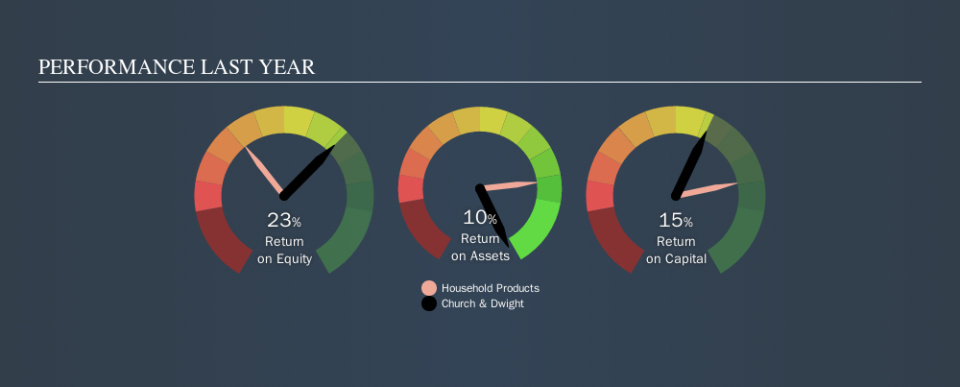Is Church & Dwight Co., Inc. (NYSE:CHD) Better Than Average At Deploying Capital?

Today we'll look at Church & Dwight Co., Inc. (NYSE:CHD) and reflect on its potential as an investment. Specifically, we're going to calculate its Return On Capital Employed (ROCE), in the hopes of getting some insight into the business.
First of all, we'll work out how to calculate ROCE. Then we'll compare its ROCE to similar companies. And finally, we'll look at how its current liabilities are impacting its ROCE.
What is Return On Capital Employed (ROCE)?
ROCE is a metric for evaluating how much pre-tax income (in percentage terms) a company earns on the capital invested in its business. Generally speaking a higher ROCE is better. In brief, it is a useful tool, but it is not without drawbacks. Renowned investment researcher Michael Mauboussin has suggested that a high ROCE can indicate that 'one dollar invested in the company generates value of more than one dollar'.
How Do You Calculate Return On Capital Employed?
Analysts use this formula to calculate return on capital employed:
Return on Capital Employed = Earnings Before Interest and Tax (EBIT) ÷ (Total Assets - Current Liabilities)
Or for Church & Dwight:
0.15 = US$824m ÷ (US$6.7b - US$1.2b) (Based on the trailing twelve months to June 2019.)
So, Church & Dwight has an ROCE of 15%.
Check out our latest analysis for Church & Dwight
Does Church & Dwight Have A Good ROCE?
ROCE is commonly used for comparing the performance of similar businesses. Using our data, Church & Dwight's ROCE appears to be around the 13% average of the Household Products industry. Regardless of where Church & Dwight sits next to its industry, its ROCE in absolute terms appears satisfactory, and this company could be worth a closer look.
Church & Dwight's current ROCE of 15% is lower than its ROCE in the past, which was 21%, 3 years ago. This makes us wonder if the business is facing new challenges. You can see in the image below how Church & Dwight's ROCE compares to its industry. Click to see more on past growth.
Remember that this metric is backwards looking - it shows what has happened in the past, and does not accurately predict the future. ROCE can be misleading for companies in cyclical industries, with returns looking impressive during the boom times, but very weak during the busts. ROCE is, after all, simply a snap shot of a single year. Future performance is what matters, and you can see analyst predictions in our free report on analyst forecasts for the company.
How Church & Dwight's Current Liabilities Impact Its ROCE
Liabilities, such as supplier bills and bank overdrafts, are referred to as current liabilities if they need to be paid within 12 months. The ROCE equation subtracts current liabilities from capital employed, so a company with a lot of current liabilities appears to have less capital employed, and a higher ROCE than otherwise. To counteract this, we check if a company has high current liabilities, relative to its total assets.
Church & Dwight has total liabilities of US$1.2b and total assets of US$6.7b. As a result, its current liabilities are equal to approximately 18% of its total assets. Current liabilities are minimal, limiting the impact on ROCE.
Our Take On Church & Dwight's ROCE
This is good to see, and with a sound ROCE, Church & Dwight could be worth a closer look. Church & Dwight looks strong on this analysis, but there are plenty of other companies that could be a good opportunity . Here is a free list of companies growing earnings rapidly.
There are plenty of other companies that have insiders buying up shares. You probably do not want to miss this free list of growing companies that insiders are buying.
We aim to bring you long-term focused research analysis driven by fundamental data. Note that our analysis may not factor in the latest price-sensitive company announcements or qualitative material.
If you spot an error that warrants correction, please contact the editor at editorial-team@simplywallst.com. This article by Simply Wall St is general in nature. It does not constitute a recommendation to buy or sell any stock, and does not take account of your objectives, or your financial situation. Simply Wall St has no position in the stocks mentioned. Thank you for reading.


